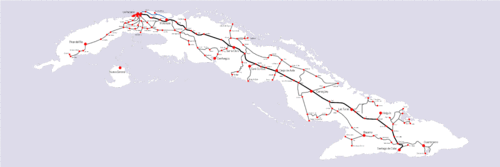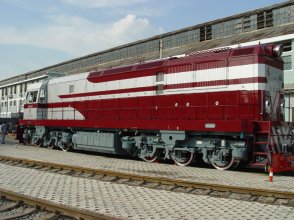(FCC) or Ferrocarriles Nacionales de Cuba (English: National Railway Company of Cuba), the only railway operating in the Caribbean islands, provides passenger and freight services for Cuba.
FCC uses 1,435 mm (4 ft 8 1⁄2 in) (standard gauge) that extends from Guane (province Pinar del Río) in the westernmost part of the island up to the bay of Guantánamo in the eastern part.
Most of the 4,226 km is diesel with 140 km electrified. The branch to Trinidad in the south coast is damaged at a bridge and the rail service there is no longer connected to the rest of the national rail network. Local railcars run from the damaged bridge through Trinidad to the coast daily plus a steam locomotive and two home-built coaches on tourist tours through the sugar cane valleys of the Escambray Mountains.
The flagship Tren Francés (“French train”) travels between Havana and Santiago de Cuba and is operated by coaches originally used in Europe between Paris and Amsterdam on the ex-TEE service. The train is formed by 12 coaches and a Chinese-built diesel locomotive. The Hershey Railway is an electrified railway from Havana to Matanzas that was built by the Hershey Company in order to facilitate transport of workers and products after it had bought sugar plantations in 1916. It is a commuter service running in northern Havana and Matanzas provinces, and some original equipment still exists.
History
In 1836 Gaspar Betancourt Cisneros established a horse drawn railway service called Ferrocarril de Camagüey a Nuevitas in Camagüey (Puerto Príncipe).
Cuba’s railway history began on October 12, 1834 when the regent queen of Spain Maria Christina of the Two Sicilies approved the building of the first line. When the Compania de Caminos de Hierro de La Habana opened the 27.5 km line from Havana to Bejucal on November 19, 1837, it was the first steam railway line in Latin America. At this point Spain did not possess any railroad lines. The 27.5 km long line from Havana was extended by an additional 17 km to Guines on 19 November 1839. By December 1843 the cities San Felipe and Batabano were added to the rail network and further extensions were added in 1847 (17 km), 1848 (21 km), and 1849 (21 km). Havana had its first streetcar (Ferrocarril Urbano de la Habana) when its service commenced on 3 February 1859.
Pre-Revolutionary Cuba
American born Canadian railway builder Sir William Van Horne helped expand Cuba’s railway network in the early 20th Century. He was an investor in the Cuba Railroad Company (founded 1902). In 1924 Ferrocarriles Consolidados de Cuba was created from a dispute between Ferrocarriles Consolidados de Cuba and .
Other railway companies would form and merge together in the 1920s: Ferrocarriles del Norte de Cuba 1916; Ferrocarril Espirituano Tunas de Zaza; Ferrocarril Guantánamo y Occidente.
From 1940 to 1959 Cuba’s railway system was interrupted by fuel shortage during and after World War II. They were replaced by buses, which transported both passengers and freight. A few sugar factories switched over to diesel electric locomotives to haul freight.
Train ferry
Prior to the revolution there was a train ferry between Miami and Havana. The West India Fruit and Steamship Company was one of a number of companies to provide such service.
Post-Revolutionary Cuba
The destruction of Batista’s armoured train by the revolutionaries in the Battle of Santa Clara in December 1958 was an important stepping stone in the Cuban revolution. After the revolution in 1959, the Ferrocarriles Nacionales de Cuba was created by nationalizing the private and public railway systems. MINAZ continued to operate a separate railway system, mainly to transport sugar products.
From 1963 to 1966, British Rail helped the national railway obtain newer locomotives which were based on the Brush Type 4 locomotives at the time being built at Brush Traction in Loughborough, but the final assembly of the Cuban locomotives was performed at Clayton Equipment Company Hatton, Derbyshire.
After the Cuban missile crisis, it became harder for Cuba to buy new railway equipment because of the United States embargo against Cuba. Some trains were delivered via shipment with ships from third countries like the Socialist Federal Republic of Yugoslavia. For example, the British locomotive shipped from Hull using Yugoslavian ships. Purchase of new trains and parts to Cuba with the Western Bloc, stopped from the late 1960s, was replaced through trade with the Eastern Bloc. This trade link collapsed with the fall of the Soviet Union. Cuba was able to obtain used trains, and even new locomotives, from friendly nations not affected by the embargo:
5 Type RSC18 locomotives were shipped from Canada
9 electrical motor coaches from Ferrocarrils de la Generalitat de Catalunya (FGC) (Catalonian Government Railways) of Spain
Starting from 2000, the Cuban railway network was improved by more second hand equipment. Larger number now used vehicles were coming from Canada, Mexico and Europe. In 2002 used light rubbing cars (BR771) from Germany.
Much of Cuba’s trains are diesel and only a handful are steam locomotives remain for the sugar industry and the tourism industries.
After the 1990s, China became the new supplier of railway cars for Cuba. In 2006, 12 new locomotives (Type DF7G-C at 2,500 hp/1,900 kW) were shipped to Cuba. China Railways also sold some of their retired cars.
Recent developments
On September 25, 2007, investors from the Venezuelan Bank for Socio-Economic Development (BANDES) reached an agreement with transportation officials in Cuba to invest US$100 million for infrastructure improvements and repairs to Cuba’s rail network. The work is expected to help increase the average speed of trains on Cuba’s railways from 40 km/h (25 mph) to 100 km/h (62 mph). As part of the agreement, Cuban engineers will also work on similar projects on Venezuela’s rail network. In October 2007, the Cuban railways ordered two hundred passenger cars and 550 freight wagons from Iranian manufacturer Wagon Pars.
In May 2010, the Cuban government announced wide-ranging plans to repair the railway network, buy new rolling stock, and open four centres to train railway workers.
Model Manufacturer Numbers Notes
TE114K Diesel locomotive [ru] Voroshilovgrad Locomotive Factory, USSR 108
TEM2TK Diesel locomotive [ru] Bryansk Engineering Works [ru], USSR 79
DVM-9 diesel electric locomotive MÁVAG (Ganz), Hungary 70
MX624 Diesel locomotive MLW, Canada 50 imported in 1976
G8 Diesel locomotive General Motors Electro-Motive Division, USA 51
TEM4 Diesel locomotive Bryansk Engineering Works [ru], USSR 40
040-DE diesel electric locomotive Brissonneau et Lotz, France 42 Similar to French BB 63000 [fr]
TEM15 Diesel locomotive Voroshilovgrad Locomotive Factory, USSR 25
GMD GMD1 Diesel locomotive switcher General Motors Electro-Motive Division, USA 21 Sold in 1990s by CN Rail
M62K Diesel locomotive Voroshilovgrad Locomotive Factory, USSR 20
C30-7 Diesel locomotive GE Transportation Systems, USA 19 Acquired via Mexico
BR 771 railbuses [de] VEB Waggonbau Bautzen, GDR 17 all sold after 2000
BR 971 railbuses [de] VEB Waggonbau Bautzen, GDR 3
BR 772 railbuses [de] VEB Waggonbau Bautzen, GDR 15
BR 972 railbuses [de] VEB Waggonbau Bautzen, GDR 22
DF7G-C diesel electric locomotive CNR Beijing February 7 Locomotive Works, China 47/112 again supplied 2005/2006/2008–2009–2010
DF7K-C diesel electric locomotive CNR, China 5 First 5 arrived in 2008
GMD1 Diesel locomotive General Motors Electro-Motive Division, Canada 12 From Canadian National Railway to Cuba in 1999.
Freight cars are mainly acquired from the former East Bloc countries and the then USSR whereas passenger cars from Cuban friendly countries (Spain, Japan, Canada and France)].
Sources: Wikipedia/FerrocarrilesdeCuba/Hershey/TheCubanHistory.com







